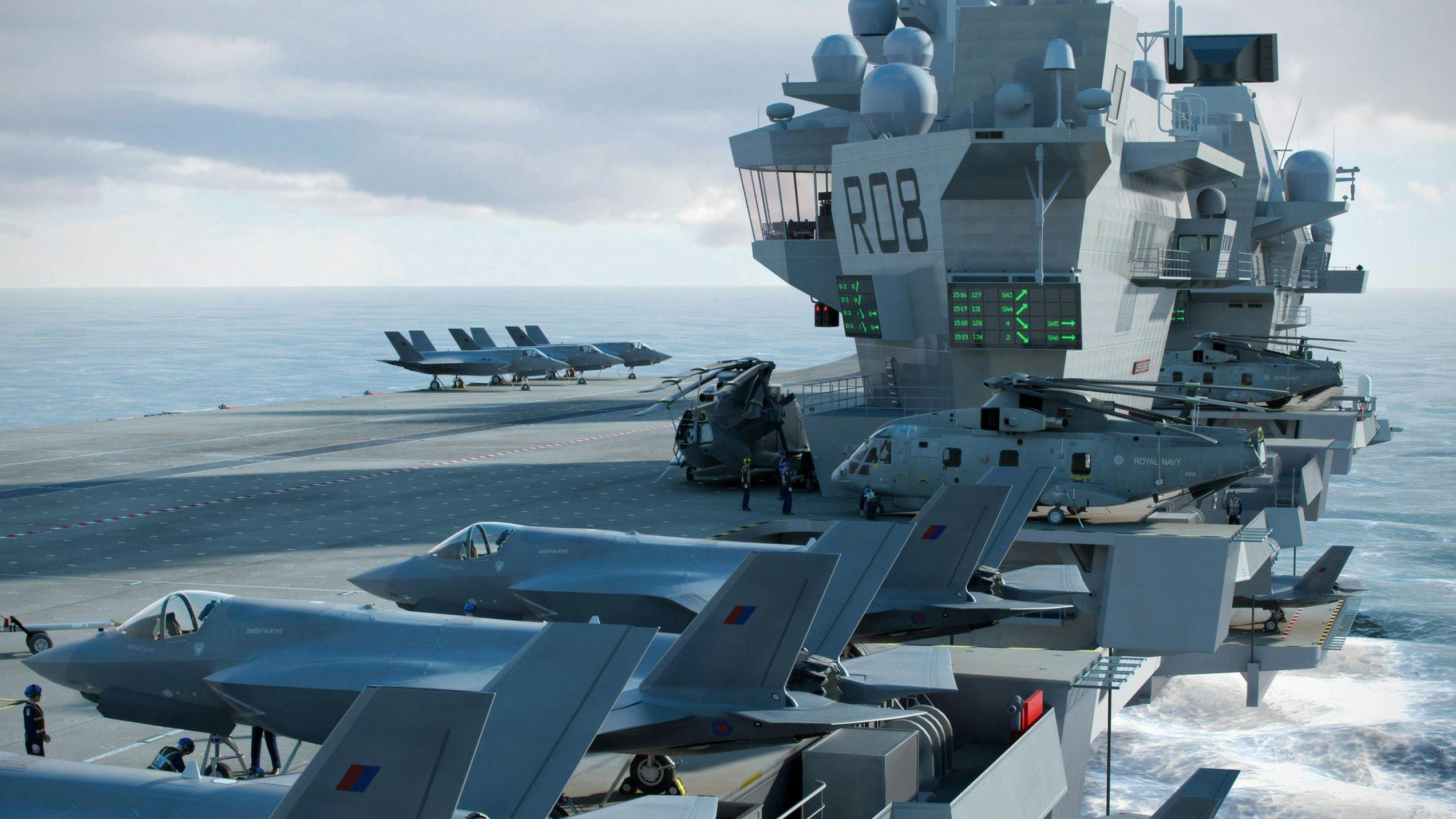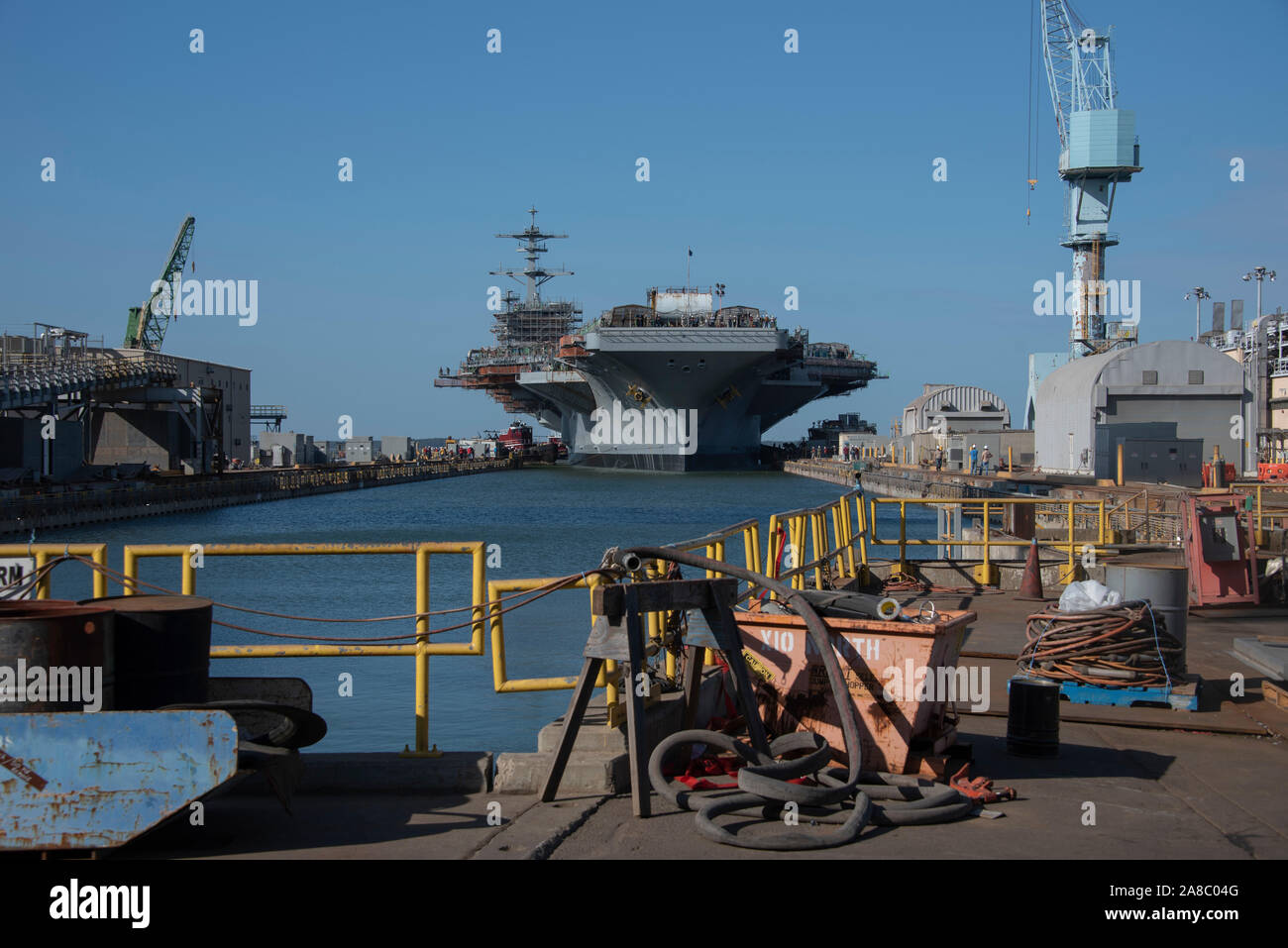Refueling Nuclear Aircraft Carrier - This article requires additional citations for validation. Please help improve this article by adding citations to reliable sources. Unsourced material may be challenged and removed. Find Resources: "A1B Reactor" - News · Newspapers · Books · Scholarship · JSTOR (December 2018) (Learn how and where to remove this message template)
In 2013, the Aircraft Carrier Readiness Unit (PCU) Gerald R. Ford (CVN-78) moved to Pier 3 at Newport News Shipbuilding for 28 months of outfitting and testing.
Refueling Nuclear Aircraft Carrier

The A1B reactor is an aircraft carrier nuclear reactor developed by the United States Navy. It is used on the Gerald R. Ford class aircraft carriers to provide electrical and propulsion power. The A1B was the first naval reactor built by the Bechtel Corporation, which "provided engineering and/or construction services for more than 80 percent of [land-based] nuclear power plants in the United States."
Photo Release Northrop Grumman Redelivers Uss Dwight D. Eisenhower (cvn 69) After Successful Refueling And Complex Overhaul
The aircraft carrier's nuclear reactors provide the ship with electrical and propulsion power by splitting enriched uranium to produce heat and turn water into steam in steam turbines. This process is almost the same as land-based nuclear power plants, the most significant difference being the direct use of turboshaft power to turn the ship's propellers. Over decades of development, many other design differences emerged between naval reactors and the typically larger power plant reactors.
As Navy planners developed requirements for the Gerald R. Ford class, they concluded that the A4W reactors that provided propulsion and power for the predecessor Nimitz-class aircraft carriers offered too little power for the ship's current and anticipated future needs,
The new reactor was named A1B, following the Navy's reactor designation scheme of type, generation, and manufacturer: A for aircraft carrier, 1 for the manufacturer's first reactor design, and B for Bechtel.
The improved overall plant efficiency is expected to enable better performance of both the propulsion and electrical systems. Using A4W data
Us Carrier John C. Stennis Starting 4 Year Nuclear Refueling Overhaul
With a 25% increase in thermal output, the A1B reactors would likely produce enough steam to provide 125 megawatts (168,000 hp) of electricity, plus 350,000 horsepower (260 MW) from a single reactor alone to drive four propeller shafts.
The increased electric propulsion capacity will allow the ship's steam to be eliminated, reducing the need for maintenance personnel.
Also, the use of electric aircraft catapults (EMALS) will free the ship's air wing from the steam limitations of the reactor plant, unlike the steam catapults used to launch aircraft on Nimitz-class carriers, which rely on steam supplied by the nuclear reactor.

The A1B reactor uses modernized technology that is both more advanced and more adaptable than previous reactor technology, is smaller and lower than the A4W, and has operator interfaces that are also expected to be improved. The future of some Navy and Marine Corps programs remains in doubt as a temporary funding bill takes effect Monday. More than a week ago, Congress approved a six-month spending package that will give the House and Senate until March 2013 to decide how to meet the nation's financial obligations, including funding for the Department of Defense (DoD).
Uss Enterprise (cvn 65)
So-called Continuing Resolutions (CRs) allow the government to remain open and operational, but they also prevent the Department of Defense from starting any new programs and require funding levels for existing programs to remain the same. For the Defense Department overall, continued funding means a half-percent increase across the board, but the bill's limitations hit the Navy and Marine Corps particularly hard. Shipbuilding programs could grind to a halt and could delay multi-year purchases of fighter jets and vertical-lift aircraft, adding to costs and affecting readiness.
The aircraft carrier USS Theodore Roosevelt (CVN 71) departed Naval Station Norfolk and began a towing operation at Northrop Grumman Newport Shipyard for a 2009 Refueling Complex (RCOH) overhaul. Navy photo.
But two of the Navy's biggest problems with CR are funding two mid-life carrier maintenance projects called RCOHs, or Refueling and Complex Overhaul. NOW
(CVN 71) was scheduled to complete its three-year, $2.5 billion refit in June 2013, but CR funded only half of the projected cost. NOW
Navy Allowing Many Uss George Washington Sailors To Move Off Ship After Deaths And Suicides
(CVN 72) is scheduled to begin discontinuing next year, but new programs are expressly prohibited under the CR.
But even as the Senate works through House-passed CR language, Defense Department Comptroller Robert Hale is raking in funding from elsewhere in the Department to pay for these two purported programs. In a $219.1 million reprogramming action sent to Capitol Hill on Tuesday, Hale asked Congress for approval to shift excess funds from seven staff accounts to three "higher priority items." Approval by the House and Senate Defense Committees gives the Navy the authority - and funding - to complete RCOH on TR and begin procurement of flagship items for
Will receive an additional $68 million to top up funds that would otherwise expire by the February deadline.

Has moved from its longtime homeport in Everett, WA to Newport, VA for its RCOH. Without the $96.1 million reprogramming request, move on
A Naval Expert Weighs In On The Waning Lifespan Of America's Beloved Aircraft Carriers
Will be delayed, the Defense Department's request said, adding that a delay would mean the Department would not be able to meet current fleet response requirements. The scheduling error also means that the Virginia shipyard performing the work must postpone planned idle work on
The reallocation of money means that, at least for now, the Navy will be able to keep its carrier in service as planned.
The Department of Defense also transferred $55 million to the DDG-1000 program to complete construction of the long-delayed ship that was once heralded as the future of the Navy's destroyer fleet. The Zumwalt class has been plagued by development delays and questions about its experimental hull design, power requirements and the utility of incorporating a stealth craft into one of the Navy's premiere power projection vessels. Congress dramatically cut the program and has since pushed the Navy to restart production of Arleigh Burke-class destroyers to meet long-term readiness needs.
Congress is also relying heavily on the Navy to maintain ships slated for retirement in the next two years. The House version of the annual defense appropriations bill prohibits the withdrawal of six cruisers and two amphibious assault ships. The Appropriations Committee funded three cruisers for next year, and their colleagues in the Senate decided to fund four.
File:us Navy 030410 N 9851b 131 The Nuclear Powered Aircraft Carrier Uss Harry S. Truman (
Last week, a Navy spokesman hinted at some flexibility in downsizing the ships, saying that four of the six Aegis-equipped cruisers —
– will remain in service until at least March “until the end of the fiscal year (FY) 2013 authorization and appropriations process or other congressional agreement.” An authorization bill is expected to be completed before the end of the calendar year, and a follow-up spending bill must be passed before the end of March.
Additional funding was not requested in the last reprogramming action for cruisers, but the Navy can use FY 2012 CR funding levels to operate and maintain the ships. Congress can also use the authorization process to allow some reductions in the fleet's force structure while forcing the Navy and Marine Corps to retain certain ships. How Hill decides to move forward and when will remain up for debate until the members return to Washington in mid-November, but it seems clear from both authority figures and appropriators that the Navy will end up retiring fewer ships in the next two years earlier than previously planned File: US Navy 060206-N-7748K-002 The nuclear-powered aircraft carrier USS Enterprise (CVN 65) prepares to refuel at sea with the guided-missile destroyer USS McFaul (DDG 74).jpg

Size of this display: 800 × 571 pixels. Other resolution: 320 x 229 pixels | 640 x 457 pixels | 1, 024 x 731 pixels | 1, 280 x 914 pixels | 2100 × 1500 pixels.
Uss George Washington (cvn 73)
Description US Navy 060206-N-7748K-002 The nuclear-powered aircraft carrier USS Enterprise (CVN 65) prepares to refuel at sea with the guided-missile destroyer USS McFaul (DDG 74).jpg
English: Atlantic Ocean (February 6, 2006) - The nuclear-powered aircraft carrier USS Enterprise (CVN 65) prepares to refuel at sea with the guided-missile destroyer USS McFaul (DDG 74). Enterprise is currently conducting routine carrier qualifications in the Atlantic Ocean. U.S. Navy photo by Petty Officer 3rd Class Josh Kinter (RELEASED)
This mark does not indicate the copyright status of the attached work. A normal copyright notice is still required. See: Licensing.
This file is the work of a US sailor or employee. Navy, taken or performed as part of that person's official duties. As a work of the US federal government, it is in the public domain in the United States.
File:us Navy 060206 N 9742r 001 The Guided Missile Destroyer Uss Mcfaul (ddg 74) Pulls Up Alongside The Nuclear Powered Aircraft Carrier Uss Enterprise (cvn 65) For A Refueling At Sea.jpg
This file is identified without known restrictions under copyright law, including all associated and related rights.
== } == {{Information |description={{en|1=Atlantic Ocean (February 6, 2006) - The nuclear-powered aircraft carrier USS Enterprise (CVN 65) prepares to refuel at sea with a guided-missile destroyer USS McFaul (DDG 74). Company
This file contains additional information such as Exif metadata that may have been added by the digital camera, scanner, or software program used to create or digitize it. If the file was modified from

Aircraft appraisal online, free aircraft appraisal, aircraft appraisal services, aircraft appraisal cost, aircraft appraisal jobs, aircraft appraisal course, aircraft appraisal training, business appraisal, rolex appraisal, appraisal software, 409a appraisal, aircraft appraisal report
Post A Comment:
0 comments so far,add yours